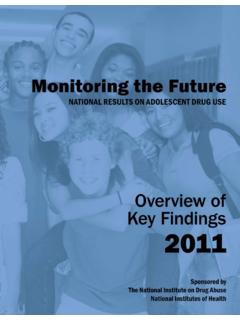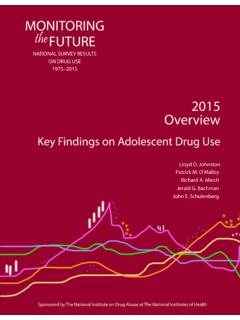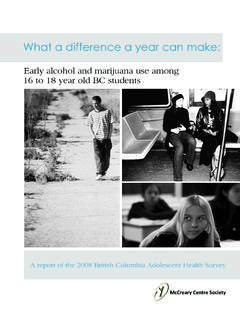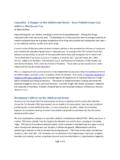Transcription of National Adolescent Drug Trends in 2017: Findings Released
1 December 14, 2017. Contacts: Nicholas Prieur, 734-763-5043, Tables summarizing estimates for the drugs discussed below, as well as additional drugs, are here: The Findings summarized here will be published by the end of January in a forthcoming volume. National Adolescent Drug Trends in 2017: Findings Released Marijuana Use Edges Upward ANN ARBOR Marijuana use among adolescents edged upward in 2017, the first significant increase in seven years. Overall, past-year use of marijuana significantly increased by to 24% in 2017 for 8th, 10th, and 12th graders combined.
2 Specifically, in 8th, 10th, and 12th grades the respective increases were (to ), (to ) and (to ). The increase is statistically significant when all three grades are combined. This increase has been expected by many said Richard Miech, the Principal Investigator of the study. Historically marijuana use has gone up as adolescents see less risk of harm in using it. We've found that the risk adolescents see in marijuana use has been steadily going down for years to the point that it is now at the lowest level we've seen in four decades.
3 The results come from the annual Monitoring the Future study, now in its 43rd year. About 45,000 students in some 380 public and private secondary schools have been surveyed each year in this National study, designed and conducted by research scientists at the University of Michigan's Institute for Social Research and funded by the National Institute on Drug Abuse. Students in grades 8, 10 and 12 are surveyed. This increase in marijuana drove Trends in any illicit drug use in the past year. In both 12th and 10th grade this measure increased (although the increase was not statistically significant), while use of any illicit drug use other than marijuana declined (although the decrease was not statistically significant).
4 In 8th grade neither of these drug use measures significantly changed, although they both increased slightly. first -Ever Standard Estimates for Vaping of Nicotine, Marijuana, and Flavoring The 2017 survey also reports first -ever National , standard estimates of nicotine vaping, marijuana vaping, flavoring-only vaping, and any vaping. Previously, no National study has published estimates for vaping of specific substances for the standard time periods of past 30 days, past year, and lifetime. Levels of marijuana vaping are considerable.
5 One in ten 12th grade students vaped marijuana in the past year, and levels were 8% and 3% for 10th and 8th grade students, respectively. These annual levels are about the same as the levels for lifetime prevalence1 of vaping marijuana use, indicating that almost all marijuana vaping had occurred within one year of the survey. 1. Levels of nicotine vaping are also considerable, with 19% of 12th grade students vaping nicotine in the past year. The annual prevalence levels were 16% and 8% for 10th and 8th grade students, respectively.
6 It is also possible that additional students are getting nicotine in what they vape but are not aware of it, so these are lower bound estimates. Levels of overall vaping were similar in 2017 to their previous levels in 2016, although the measures are not directly comparable. Updated vaping questions in 2017 asked about vaping of specific substances, while in previous years vaping questions were about any vaping in general. With this caveat, the percentage of students in 2017 who reported vaping flavoring, marijuana, or nicotine was similar to those who reported that they had vaped anything in 2016, with the two respective percentages for use in the past 30 days at 17% in 2017and 13%.
7 In 2016 among 12th grade students, 13% and 11% for 10th grade students, and 7% and 6% for 8th grade students. These Findings emphasize that vaping has progressed well beyond a cigarette alternative, said Richard Miech. Vaping has become a new delivery device for a number of substances, and this number will likely increase in the years to come.. Cigarettes and Several Other Tobacco Products Decline in Use Cigarette smoking by teens continued to decline in 2017. For the three grades combined, all measures (lifetime, 30-day, daily, and half-pack/day) are at historic lows since first measured in all three grades in 1991.
8 Since the peak levels reached in the mid-1990s, lifetime prevalence has fallen by 71%, 30-day prevalence by 81%, daily prevalence by 86%, and current half-pack-a-day prevalence by 91%. The prevalence of smoking a half-pack-per-day in the 30 days before the survey now stands at just for 8th graders, for 10th graders, and for 12th graders. The health implications of these dramatic declines in smoking are enormous for this generation of young people says Lloyd Johnston, the previous director of the study.
9 Long-term increases in perceived risk and personal disapproval of smoking have accompanied these changes, as has a long-term drop in the perceived availability of cigarettes to these age groups.. Lifetime prevalence and daily prevalence both fell significantly in 2017; 30-day prevalence fell, but not significantly, and half-pack-a day prevalence held steady at low levels. Smokeless tobacco also showed a continuing decline this year with 30-day prevalence reaching a low point for the three grades individually and combined.
10 It has fallen for the grades combined by nearly two-thirds, from in 1992 to in 2017, including a non-significant drop in 2017 of Snus, a form of smokeless tobacco, showed a significant decline in use this year for the three grades combined (annual prevalence fell from to ). Use of a hookah pipe to smoke tobacco had been increasing earlier in the decade and reached a substantial proportion of the age group, but annual prevalence has fallen by more than half since 2014, from 23% to 10%. in 2017 for the three grades combined (including a significant decline this year of percentage points).











